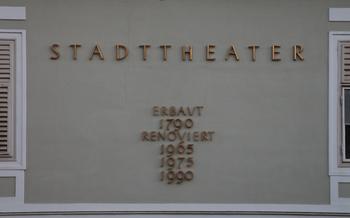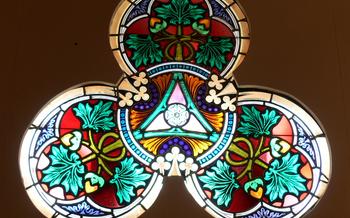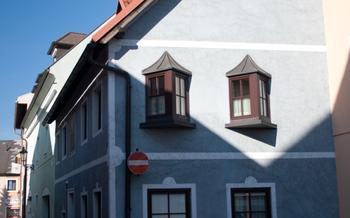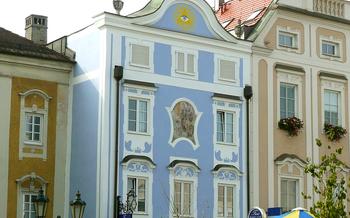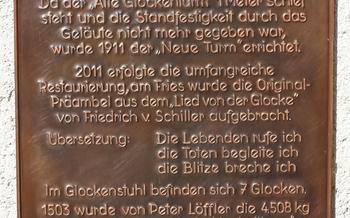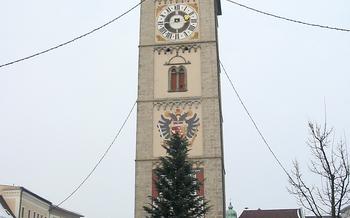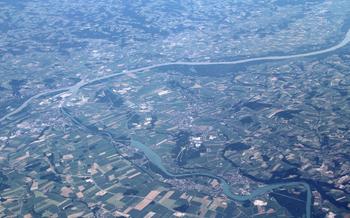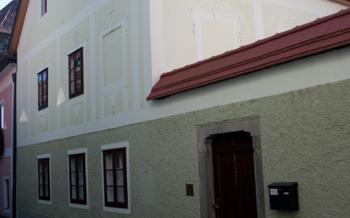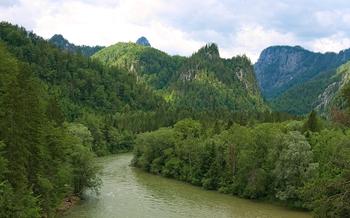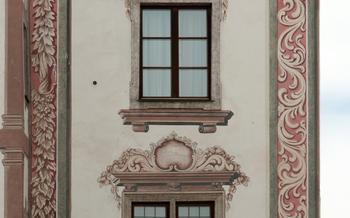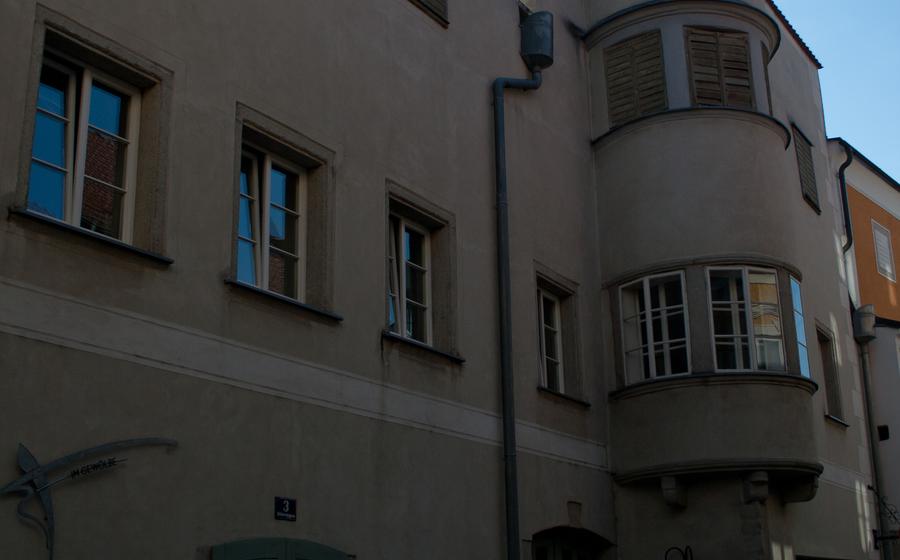
Schloss Eggenberg (Eggenberg Palace)
- A Symbol of Power and Grandeur
- Stepping into the Past
- The Hall of Planets
- Exploring the State Rooms
- The Mirror Room
- The Eggenberg Art Collection
- The Palace Gardens
- Special Exhibitions and Events
- Guided Tours and Audio Guides
- Accessibility and Facilities
- Location and Transportation
- Ticket Prices and Hours of Operation
- Suggested Itineraries
- Photography and Social Media
- A Secret Passageway and Hidden Chapel
A Symbol of Power and Grandeur
Schloss Eggenberg stands as a testament to the power and grandeur of the Eggenberg family, who rose to prominence in the 17th century. Commissioned by Prince Hans Ulrich von Eggenberg, the palace was constructed between 1625 and 1635, reflecting the family's wealth and influence. Its opulent Baroque architecture, featuring intricate facades, elaborate sculptures, and sprawling gardens, exudes an aura of majesty that captivates visitors to this day.
Initially conceived as a hunting lodge, Schloss Eggenberg served as a retreat for the Eggenberg family during their hunting expeditions in the nearby forests. However, its grandeur and strategic location soon transformed it into a sumptuous residence, where the family hosted lavish parties and entertained distinguished guests. The palace's opulence and grandeur mirrored the Eggenberg family's status and power, solidifying their position among the most influential noble families in the region.
Stepping into the Past
Schloss Eggenberg's transformation into a museum has preserved its legacy for future generations. The palace's remarkably well-maintained state allows visitors to step back in time and immerse themselves in its opulent grandeur. Exploring its meticulously restored interiors is like embarking on a journey through history, providing a glimpse into the lives of the noble families who once called this magnificent residence home. From the grand state rooms to the intimate private chambers, each space tells a story of power, wealth, and aristocratic privilege. Visitors can wander through these lavishly decorated rooms, admiring the intricate artwork, opulent furnishings, and personal artifacts that once belonged to the Eggenberg family, gaining a deeper understanding of their lifestyle and the social and cultural context of their time.
The Hall of Planets
Amongst the many wonders of Schloss Eggenberg, the Hall of Planets stands out as a masterpiece of Baroque artistry and astronomical symbolism. This grand hall, named for the seven celestial bodies painted on its ceiling frescoes, takes visitors on a journey through the cosmos. The planets, each depicted with its own unique iconography and mythology, are arranged in a harmonious celestial dance, reflecting the Baroque fascination with astrology and the harmony of the universe.
The ceiling frescoes, executed by the renowned artist Johann Georg Melchior Schmidtner, are a breathtaking display of vibrant colors and intricate details. Each planet is accompanied by its astrological symbol and surrounded by allegorical figures representing the associated gods and goddesses from Greek and Roman mythology. The sun, the central figure of the composition, is depicted as Apollo, the god of light and music, while the moon is represented by Diana, the goddess of the hunt and nature.
The Hall of Planets is not merely a testament to artistic virtuosity but also a reflection of the scientific knowledge and cultural beliefs of the Baroque era. The frescoes embody the contemporary understanding of the cosmos, blending astronomy, astrology, and mythology into a cohesive visual narrative. Visitors can marvel at the intricate details of the celestial bodies, the expressive gestures of the allegorical figures, and the overall harmony of the composition.
Exploring the State Rooms
Stepping into the state rooms of Schloss Eggenberg is like stepping back in time to the opulent era of the noble families who once resided here. These grand chambers, meticulously preserved and restored, offer a glimpse into the lavish lifestyle and refined tastes of the Eggenbergs and their guests.
The state rooms exude an aura of grandeur, with their soaring ceilings, intricate stucco work, and gleaming parquet floors. Each room is adorned with elaborate furnishings, tapestries, and artwork, reflecting the wealth and power of the Eggenberg family.
Visitors can admire the grand dining room, where formal banquets and celebrations were once held. The room features a massive table that could accommodate up to 24 guests, intricately carved chairs, and a magnificent chandelier that illuminates the space.
The music room, with its exquisite acoustics, hosted intimate concerts and performances for the entertainment of the nobility. The walls are adorned with musical instruments, including violins, lutes, and harpsichords, hinting at the Eggenbergs' passion for the arts.
The state bedrooms, with their plush velvet drapes, ornate beds, and elegant dressing tables, offer a glimpse into the private lives of the palace's former occupants. The attention to detail and luxurious amenities reflect the refined tastes and comfort that the Eggenbergs sought in their living quarters.
Exploring the state rooms of Schloss Eggenberg is a journey through history, immersing visitors in the grandeur and opulence of a bygone era. These rooms provide a fascinating glimpse into the lives of the noble families who shaped the history of this magnificent palace.
The Mirror Room
Among the many awe-inspiring chambers within Schloss Eggenberg, the Mirror Room stands out for its striking visual allure and profound symbolic significance. Step into this resplendent space, and you'll be greeted by an extraordinary spectacle of mirrors, their polished surfaces reflecting the room's grandeur in a mesmerizing kaleidoscope of light and depth.
The walls of the Mirror Room are adorned with intricate mirror work, creating the illusion of infinite space and reflecting the opulent furnishings and artwork that grace the chamber. The ceiling, a masterpiece of Baroque artistry, features a fresco depicting the Triumph of Hercules, further enhancing the sense of grandeur and mythological symbolism that permeates the room.
This breathtaking chamber served as a reception room for distinguished guests, where the noble Eggenberg family would host lavish banquets and social gatherings. The mirrors, with their ability to multiply and reflect the surrounding splendor, were not merely decorative elements but also a testament to the family's wealth and power.
Today, the Mirror Room remains a popular spot for photography and admiration, captivating visitors with its unique visual features and symbolic meaning. It is a true masterpiece of Baroque architecture and a highlight of any visit to Schloss Eggenberg.
The Eggenberg Art Collection
The Eggenberg Art Collection is a treasure trove of artistic masterpieces housed within the palace's grand halls. The collection boasts an impressive array of paintings, sculptures, and tapestries that showcase the refined taste and cultural patronage of the Eggenberg family. Visitors can admire works by renowned artists such as Pieter Brueghel the Younger, Hans Holbein the Younger, and Lucas Cranach the Elder. The collection also includes a remarkable series of portraits depicting members of the Eggenberg family, offering a glimpse into the lives and personalities of these influential figures.
The Eggenberg Art Collection is not only a testament to the family's wealth and power but also a reflection of their intellectual and cultural pursuits. The artworks on display span a wide range of subjects, from religious and mythological themes to landscapes and still lifes. They provide a fascinating glimpse into the intellectual and artistic climate of the 17th and 18th centuries.
The collection's highlights include the "Allegory of the Vanities of the World" by Pieter Brueghel the Younger, a poignant depiction of the transience of earthly possessions. Hans Holbein the Younger's "Portrait of a Young Man" captures the essence of Renaissance humanism with its realistic portrayal of the sitter's individuality. Lucas Cranach the Elder's "Venus and Cupid" is a sensual and mythological masterpiece that showcases the artist's skill in depicting the female form.
Whether you are an art enthusiast or simply appreciate beauty, the Eggenberg Art Collection is a must-see for anyone visiting Schloss Eggenberg. It offers a unique opportunity to delve into the artistic and cultural heritage of the Eggenberg family and gain insights into the artistic landscape of the Baroque era.
The Palace Gardens
The grandeur of Schloss Eggenberg extends beyond its opulent interiors to encompass its stunning gardens. Designed in a formal Baroque style, the gardens are a feast for the eyes, offering a serene and picturesque escape from the bustling city. Visitors can stroll along manicured paths, admire intricate flower beds, and marvel at the impressive sculptures and fountains that adorn the grounds.
The gardens are a testament to the Eggenberg family's love of nature and their appreciation for beauty. They were designed to complement the architectural magnificence of the palace, creating a harmonious blend of nature and human artistry. Visitors can wander through the gardens, taking in the sights and sounds of nature while immersing themselves in the history and culture of the Eggenberg family.
One of the highlights of the gardens is the grand fountain, which serves as a centerpiece and focal point. The fountain is adorned with intricate carvings and statues, symbolizing the power and wealth of the Eggenberg family. It is a popular spot for visitors to relax and enjoy the tranquility of the surroundings.
The gardens also feature a variety of other attractions, including a maze, a grotto, and a rose garden. The maze is a fun and challenging diversion for visitors of all ages, while the grotto offers a glimpse into the whimsical and imaginative world of the Baroque period. The rose garden, with its vibrant colors and fragrant blooms, is a popular spot for visitors to take a break and soak in the beauty of nature.
Whether you are a nature lover, a history buff, or simply looking for a tranquil escape, the gardens of Schloss Eggenberg are a must-visit. They offer a unique and unforgettable experience that is sure to leave a lasting impression.
Special Exhibitions and Events
Schloss Eggenberg not only captivates visitors with its permanent collection but also hosts a dynamic array of temporary exhibitions and cultural events throughout the year. These exhibitions explore diverse themes and topics, ranging from art and history to science and contemporary issues. The palace's grand halls and galleries provide a stunning backdrop for these exhibitions, creating a truly immersive experience for visitors.
One of the highlights of the palace's cultural offerings is the annual Eggenberg Renaissance Festival. This vibrant festival transports visitors back in time, showcasing the opulence and grandeur of the Renaissance era. Visitors can witness historical reenactments, indulge in medieval feasts, and enjoy traditional music and dance performances.
Schloss Eggenberg also hosts regular concerts, lectures, and workshops, inviting renowned artists, scholars, and experts to share their knowledge and passion with the public. These events offer visitors the opportunity to delve deeper into the palace's history, art, and cultural significance.
By hosting these special exhibitions and events, Schloss Eggenberg strives to engage and inspire visitors, offering them a rich and diverse cultural experience that complements the palace's magnificent architecture and historical significance.
Guided Tours and Audio Guides
Schloss Eggenberg offers guided tours in various languages, providing visitors with an immersive and informative experience. These tours are led by knowledgeable guides who share fascinating insights into the palace's history, architecture, and art collection. Guided tours typically cover the state rooms, the Hall of Planets, the Mirror Room, and the palace gardens, allowing visitors to delve deeper into the stories and significance behind each space.
For those who prefer a more independent exploration, audio guides are available in multiple languages. These audio guides offer a self-guided tour experience, allowing visitors to explore the palace at their own pace and focus on specific aspects that interest them. The audio guides provide detailed commentary and explanations, ensuring that visitors don't miss any important details or hidden gems.
Whether you choose a guided tour or an audio guide, exploring Schloss Eggenberg with the help of these resources will greatly enhance your understanding and appreciation of this magnificent palace.
Accessibility and Facilities
Schloss Eggenberg welcomes visitors from all walks of life and strives to provide an inclusive and accessible experience for everyone.
-
The palace features ramps, elevators, and accessible restrooms to accommodate visitors with disabilities.
-
Visitors can take advantage of the on-site café to enjoy refreshments and snacks during their visit.
-
A gift shop is also available, offering a range of souvenirs and mementos to remember your visit.
-
To make the most of your visit, plan to spend at least two hours exploring the palace and its grounds.
-
The best time to visit is during the shoulder seasons (spring and autumn) to avoid the summer crowds.
-
For those arriving by car, there are ample parking spaces available on-site.
Location and Transportation
Situated in the heart of Eggenberg, Schloss Eggenberg stands as a testament to the region's rich history and cultural heritage. To reach this magnificent palace, visitors can take advantage of the excellent public transportation network. The nearest bus stop, Schloss Eggenberg, is conveniently located just a short walk from the palace's entrance. For those arriving by car, ample parking spaces are available in the vicinity.
Once you've arrived, take a moment to admire the palace's grand facade and its beautifully landscaped gardens. The surrounding area is dotted with charming cafes, restaurants, and shops, offering visitors a chance to delve deeper into the local culture and cuisine.
Combining a visit to Schloss Eggenberg with other attractions in the region is a great way to make the most of your time in this captivating city. The nearby Eggenberg Brewery, founded in 1681, offers guided tours and tastings, allowing visitors to discover the secrets behind their renowned beers. For those interested in art and history, the nearby Eggenberg Art Museum houses an impressive collection of paintings, sculptures, and decorative arts.
Ticket Prices and Hours of Operation
Ticketing and visiting hours at Schloss Eggenberg are tailored to ensure an optimal experience for all visitors. Standard admission tickets to the palace are priced at [Ticket Price], offering access to the state rooms, the Hall of Planets, and the Eggenberg Art Collection. Reduced rates apply to students, seniors, and families, making it accessible to a wide range of visitors.
For a more in-depth exploration, guided tours are available at an additional cost. These tours offer exclusive insights into the palace's history, architecture, and art collection, led by knowledgeable guides. Visitors can choose between English, German, and Spanish language tours, ensuring inclusivity and accessibility for international guests.
Schloss Eggenberg welcomes visitors throughout the year, with varying hours of operation depending on the season. During the peak tourist season from April to October, the palace opens its doors from 10 am to 6 pm, allowing ample time to explore its wonders. In the off-season from November to March, the hours are slightly reduced, with the palace open from 10 am to 4 pm.
To avoid queues and ensure a seamless visit, online ticket purchases are highly recommended. The palace's official website offers a convenient online ticketing system, allowing visitors to secure their tickets in advance. This not only saves time but also guarantees entry, especially during busy periods.
Suggested Itineraries
One-Day Itinerary:
- Morning: Begin your day with a guided tour of the palace's grand interiors, including the Hall of Planets, the state rooms, and the Mirror Room.
- Afternoon: Explore the Eggenberg Art Collection at your own pace, admiring the diverse range of artwork on display.
- Evening: Take a leisurely stroll through the formal gardens, appreciating the beauty of the sculptures, fountains, and walkways.
Multi-Day Itinerary:
- Day 1: Dedicate the first day to exploring the palace and its surroundings. Embark on a guided tour, visit the Eggenberg Art Collection, and wander through the gardens.
- Day 2: Venture beyond the palace to discover the nearby attractions of Enns. Visit the Old Town, explore the Enns Museum, and take a boat trip on the Enns River.
Customizing Your Itinerary:
- For history buffs, spend more time delving into the palace's history and significance through guided tours and audio guides.
- Art enthusiasts can extend their visit to explore the Eggenberg Art Collection in-depth, appreciating the diverse range of artwork and its cultural significance.
- Nature lovers can dedicate more time to exploring the palace gardens, enjoying the tranquility and beauty of the surroundings.
Photography and Social Media
Schloss Eggenberg encourages visitors to capture their memories through photography, but with a few guidelines in mind. Flash photography is prohibited inside the palace to preserve the delicate artworks and furnishings. Tripods and selfie sticks are also not allowed, ensuring that everyone has an unobstructed view of the palace's grandeur.
When sharing your photos on social media, be sure to tag the palace and use the official hashtag to connect with other visitors and enthusiasts. Let your followers experience the beauty of Schloss Eggenberg through your lens and inspire them to embark on their own journey of discovery.
A Secret Passageway and Hidden Chapel
Beyond the grand halls and opulent chambers of Schloss Eggenberg lies a concealed gem – a secret passageway leading to a hidden chapel. This hidden sanctuary, tucked away from the main thoroughfares, offers a glimpse into the private religious life of the noble Eggenberg family. Visitors who venture off the beaten path can discover this secret passage and experience the serene atmosphere of the chapel, a testament to the family's deep faith and devotion.
